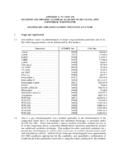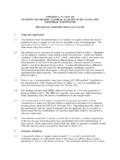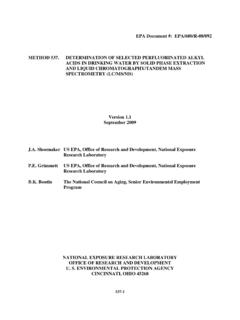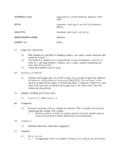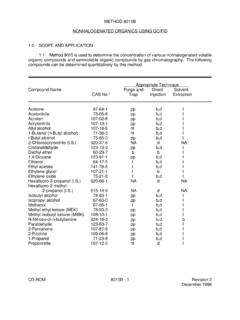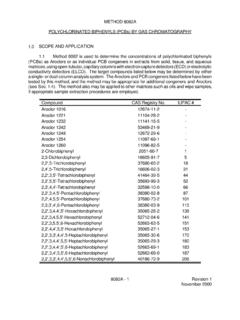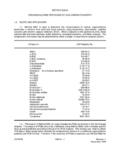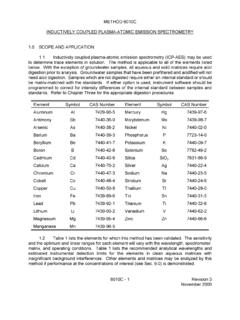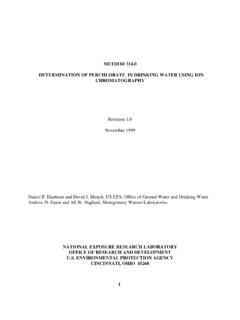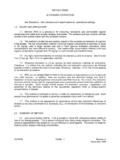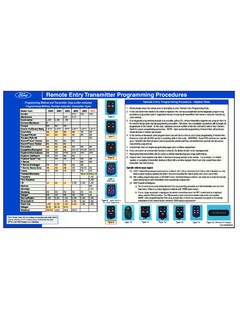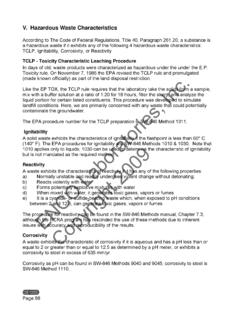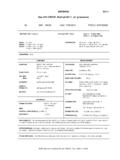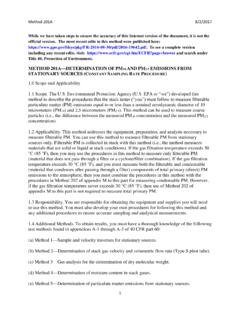Transcription of METHOD 7060A ARSENIC (ATOMIC ABSORPTION, …
1 CD-ROM7060A - 1 Revision 1 September 1994 METHOD 7060 AARSENIC ( atomic absorption , furnace technique ) SCOPE AND 7060 is an atomic absorption procedure approved fordetermining the concentration of ARSENIC in wastes, mobility procedure extracts,soils, and ground water. All samples must be subjected to an appropriatedissolution step prior to SUMMARY OF Prior to analysis by METHOD 7060, samples must be prepared in orderto convert organic forms of ARSENIC to inorganic forms, to minimize organicinterferences, and to convert the sample to a suitable solution for sample preparation procedure varies depending on the sample matrix. Aqueoussamples are subjected to the acid digestion procedure described in this samples are prepared using the procedure described in METHOD Following the appropriate dissolution of the sample, a representativealiquot of the digestate is spiked with a nickel nitrate solution and is placedmanually or by means of an automatic sampler into a graphite tube furnace .
2 Thesample aliquot is then slowly evaporated to dryness, charred (ashed), andatomized. The absorption of hollow cathode or EDL radiation during atomizationwill be proportional to the ARSENIC concentration. Other modifiers may be usedin place of nickel nitrate if the analyst documents the chemical andconcentration The typical detection limit for water samples using this METHOD is1 ug/L. This detection limit may not be achievable when analyzing waste Elemental ARSENIC and many of its compounds are volatile; therefore,samples may be subject to losses of ARSENIC during sample preparation. Spikesamples and relevant standard reference materials should be processed todetermine if the chosen dissolution METHOD is Likewise, caution must be employed during the selection oftemperature and times for the dry and char (ash) cycles. A matrix modifier suchas nickel nitrate must be added to all digestates prior to analysis to minimizevolatilization losses during drying and In addition to the normal interferences experienced during graphitefurnace analysis, ARSENIC analysis can suffer from severe nonspecific absorptionand light scattering caused by matrix components during atomization.
3 Arsenicanalysis is particularly susceptible to these problems because of its lowanalytical wavelength ( nm). Simultaneous background correction must beemployed to avoid erroneously high results. Aluminum is a severe positiveinterferent in the analysis of ARSENIC , especially using D arc background2CD-ROM7060A - 2 Revision 1 September 1994 correction. Although Zeeman background correction is very useful in thissituation, use of any appropriate background correction technique is If the analyte is not completely volatilized and removed from thefurnace during atomization, memory effects will occur. If this situation isdetected by means of blank burns, the tube should be cleaned by operating thefurnace at full power at regular intervals in the analytical APPARATUS AND Griffin beaker or equivalent: 250 Class A Volumetric flasks: atomic absorption spectrophotometer: Single or dual channel, single-or double-beam instrument having a grating monochromator, photo-multiplierdetector, adjustable slits, a wavelength range of 190 to 800 nm, and provisionsfor simultaneous background correction and interfacing with a suitable ARSENIC hollow cathode lamp, or electrodeless discharge lamp (EDL):EDLs provide better sensitivity for ARSENIC Graphite furnace : Any graphite furnace device with the appropriatetemperature and timing Data systems recorder.
4 A recorder is strongly recommended forfurnace work so that there will be a permanent record and so that any problemswith the analysis such as drift, incomplete atomization, losses during charring,changes in sensitivity, etc., can easily be Pipets: Microliter with disposable tips. Sizes can range from 5 to 1,000 uL, as Reagent water: Water should be monitored for references to water will refer to reagent Concentrated nitric acid: Acid should be analyzed to determine levelsof impurities. If a METHOD blank using the acid is <MDL, the acid can be peroxide (30%): Oxidant should be analyzed to determinelevels of impurities. If a METHOD blank using the HO is <MDL, the reagent can22be ARSENIC standard stock solution (1,000 mg/L): Either procure acertified aqueous standard from a supplier and verify by comparison with a secondstandard, or dissolve g of ARSENIC trioxide (As0, analytical reagent23grade) or equivalent in 100 mL of reagent water containing 4 g NaOH.
5 Acidify thesolution with 20 mL concentrated HNO and dilute to 1 liter (1 mL = 1 mg As).3CD-ROM7060A - 3 Revision 1 September 1994 Nickel nitrate solution (5%): Dissolve g of ACS reagent gradeNi(NO)6HO or equivalent in reagent water and dilute to 100 Nickel nitrate solution (1%): Dilute 20 mL of the 5% nickel nitrateto 100 mL with reagent ARSENIC working standards: Prepare dilutions of the stock solutionto be used as calibration standards at the time of the analysis. Withdrawappropriate aliquots of the stock solution, add concentrated HNO, 30% HO, and3225% nickel nitrate solution or other appropriate matrix modifier. Amounts addedshould be representative of the concentrations found in the samples. Dilute to100 mL with reagent SAMPLE COLLECTION, PRESERVATION, AND All samples must have been collected using a sampling plan thataddresses the considerations discussed in Chapter Nine of this All sample containers must be prewashed with detergents, acids, andreagent water.
6 Plastic and glass containers are both Special containers ( , containers used for volatile organicanalysis) may have to be used if very volatile ARSENIC compounds are to Aqueous samples must be acidified to a pH of <2 with nitric acid andrefrigerated prior to Although waste samples do not need to be refrigerated sample handlingand storage must comply with the minimum requirements established in Chapter Sample preparation: Aqueous samples should be prepared in the mannerdescribed in Paragraphs Sludge-type samples should be preparedaccording to METHOD 3050A. The applicability of a sample-preparation techniqueto a new matrix type must be demonstrated by analyzing spiked samples and/orrelevant standard reference Transfer a known volume of well-mixed sample to a 250-mLGriffin beaker or equivalent; add 2 mL of 30% HO and sufficient22concentrated HNO to result in an acid concentration of 1% (v/v).
7 Heat,3until digestion is complete, at 95C or until the volume is slightly lessothan 50 mL. Cool, transfer to a volumetric flask, and bring back to 50mL with reagent water. Pipet 5 mL of this digested solution into a 10-mL volumetricflask, add 1 mL of the 1% nickel nitrate solution or other appropriatematrix modifier, and dilute to 10 mL with reagent water. The sample isnow ready for injection into the - 4 Revision 1 September 1994 The wavelength line and a background correction system arerequired. Follow the manufacturer's suggestions for all other furnace parameters suggested by the manufacturer should be employedas guidelines. Because temperature-sensing mechanisms and temperaturecontrollers can vary between instruments or with time, the validity of thefurnace parameters must be periodically confirmed by systematically altering thefurnace parameters while analyzing a standard.
8 In this manner, losses of analytedue to overly high temperature settings or losses in sensitivity due to less thanoptimum settings can be minimized. Similar verification of furnace parametersmay be required for complex sample Inject a measured microliter aliquot of sample into the furnace andatomize. If the concentration found is greater than the highest standard, thesample should be diluted in the same acid matrix and reanalyzed. The use ofmultiple injections can improve accuracy and help detect furnace QUALITY Refer to section of METHOD METHOD Precision and accuracy data are available in METHOD of Methodsfor Chemical Analysis of Water and The optimal concentration range for aqueous samples using this methodis 5-100 ug/L. Concentration ranges for non-aqueous samples will vary withmatrix The data shown in Table 1 were obtained from records of state andcontractor laboratories.
9 The data are intended to show the precision of thecombined sample preparation and analysis REFERENCES1. methods for Chemical Analysis of Water and Wastes, EPA-600/4-82-055,December 1982, METHOD Gaskill, A., Compilation and Evaluation of RCRA METHOD Performance Data,Work Assignment No. 2, EPA Contract No. 68-01-7075, September - 5 Revision 1 September 1994 TABLE 1. METHOD PERFORMANCE DATA Sample Preparation LaboratoryMatrix METHOD Replicates Contaminated soil 3050 , ug/gOily soil 3050 , ug/gNBS SRM 1646 Estuarine sediment 3050 , ug/gaEmission control dust 3050 430, 350 ug/g Bias of -30 and -28% from expected, - 6 Revision 1 September 1994 METHOD 7060 AARSENIC ( atomic absorption , furnace technique )
